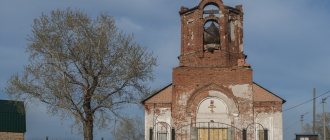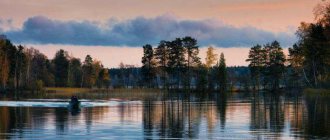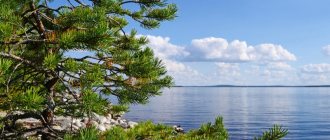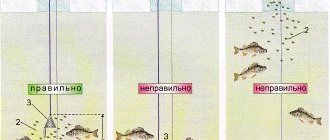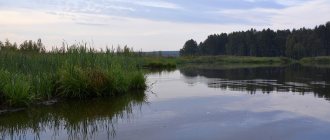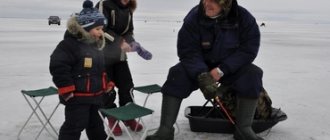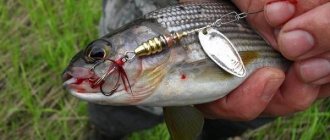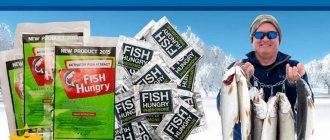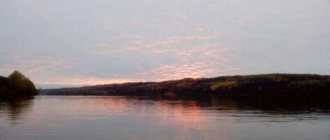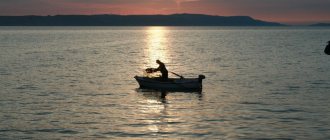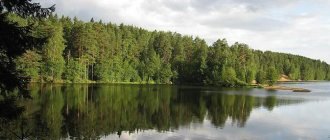general description
The area of Syamozero is 266 square kilometers, dimensions 24.6 by 15 kilometers. The length of the coastline is 159 kilometers. Volume – 1.8 cubic kilometers. There are many islands and bays on Lake Syamozero, which is explained by its glacial origin.
The Syapsya River flows out (it is a tributary of Shuya), a large number of rivers and streams flow in, the largest of them are Kudama, Kivach, MalayaSuna, Sudak, Souda. The annual amplitude of water level fluctuations is 50 centimeters, the water level is regulated naturally, there are no hydraulic structures on Syamozero.
The banks are mostly low and covered with forest. Wetlands are practically non-existent, and rocky ones are also rare. Lake Syamozero is characterized by sandy shores, which can be called beaches (therefore, the reservoir is popular among lovers of outdoor recreation).
The largest bays are Krumoilsky, Rugaguba, Lakhta, Essoilsky, Chuinavolokskaya Bay, Syargilakhta. The largest island is called Eloisvar. Most of the islands are concentrated in the northern part of the lake, there are 80 of them in total.
The transparency of the water in some places can reach 4.5 meters, in some places it does not exceed 70-80 centimeters. Has a brownish tint. The weather in the surrounding area is typical for this part of Karelia; Lake Syamozero itself has an extremely insignificant effect on the climate (not comparable to the influence of the neighboring Ladoga and Onega lakes). It usually freezes in November and breaks free of ice in early May. However, there are warm winters when the lake freezes only in December, and by the end of May it can be completely ice-free.
The area around the lake is often called Syamozerye - this is typical for Karelia, when areas get their names from bodies of water (Zaonezhye, Ladoga region, etc.).
Description of the lake
Syamozero from the Karelian lakes located in the south of the republic. Belongs to the Shuya River basin. From it 70 km east to Lake Onega and Petrozavodsk - the administrative center of Karelia.
The origin of the lake is glacial. This is evidenced by the presence of many islands within its borders, straits and bays along the shores and shallow water depths. The formation of ice on Syamozero occurs in October-December, its opening in April-May.
The length of the lake stretches for 24.6 km, has a fairly large width (15.1 km) and a total area of 266 sq. km at low water. There are places on the reservoir with a depth of 24.5 m, its average value is 6.7 m.
The lake is flowing. The largest river flowing from it is Syapsya, which flows into Shuya. Of the rivers flowing into the lake, with a length of 10...40 km, the Souda, Kudama, Kivach, Sudak, Malaya Suna are known. Their mouths are located on the northern shore of the reservoir.
The lake is oval in plan and is replete with a large number of bays. Of the latter, the largest are: Lakhta, Rugaguba, Kukhaguba, Syargilakhta, Kurmoylsky, Essoilsky, Chuinavolokskaya Bay. The surface of the lake is dotted with many (80) islands; their total area reaches 4.3 sq. km. The largest of them are Fokensuari, Kudamsuari, Kyuchinsuari, Peldosuari, Ruochinsuari.
The shores surrounding the lake have a slight elevation. They have many sandy beaches and rocky embankments. There are rocky outcrops on the banks. The bottom of the reservoir on half the area has a layer of green silt; shallow waters are sandy and rocky. There are significant areas with the bottom covered with lake ore. There are thickets of reeds and reeds near the shores.
The lake is rich in fish. In total, there are 21 species of it in the reservoir. There are noble ones - vendace, grayling, pike perch, whitefish, salmon; Among those commonly found in fishermen's catches are ruffe, silver bream, dace, bream, chub, ide, pike, roach, burbot, and perch.
Bottom relief and depth
Syamozero is not the deepest body of water. The average depth is 6.7 meters, the maximum is 24.5 meters. There is no map of the depths of Syamozero in electronic form, but there is quite detailed data regarding the depths. The area with the greatest depths is located in the western part of the lake, 2.5 kilometers from the coast. Almost along the entire coastline, at a distance of up to 1-1.5 kilometers from the shore, the depths do not exceed 5 meters, only in places they can reach up to 10 meters. In particular, there are similar areas in the northwestern part of Syamozero, which on average is much deeper than the southeastern part.
On fishing forums you can find scans of paper maps of the depths of Lake Syamozero, but they are not the most accurate and contain only general information. For fishing in this reservoir, it is recommended to have an echo sounder, since the bottom topography is generally very complex. Luds, pits, and selgi are often found.
About 65% of the bottom is covered with silt, about 20% is covered with iron ore bases, which are most often found in the east of Syamozero. In shallow waters, sandy, rocky or rocky-sandy soils predominate.
Lake Syamozero depth map
Syamozero (Karelian Seämärvi, Finnish Säämäjärvi) is a large lake in the south of Karelia, belongs to the Shuya River basin.
The lake is located 50 km west of Petrozavodsk. The lake measures 24.6 km by 15 km . The lake is not deep with an average depth of about 6 meters, a maximum depth of 24.5 meters. The bottom of the lake is rocky in shallow waters and muddy in deep areas. The shores are rocky and sandy, partially overgrown with reeds and reeds.
There are 80 islands on the lake , including several large ones, such as Fokensuari, Kudamsuari, Kyuchinsuari, Peldosuari, Ruochinsuari. The shores are replete with many bays and bays, such as Lakhta, Rugaguba, Kukhaguba, Syargilakhta, Kurmoilsky, Essoilsky, Chuinavolokskaya Bay.
flows from Syamozero , the Souda, Kudama, Kivach, Sudak, Malaya Suna and many small rivers and streams flow into the lake
About 20 species of fish live in Syamozero. There are salmon, whitefish, grayling, vendace, burbot, pike, pike perch, perch, ide, chub, bream and others. Here it is possible to catch trophy specimens of pike, pike perch and perch.
in Syamozero , the main places for fishing are near the islands in areas with a rocky bottom. The pike perch in the lake grows up to 5 kg . Closer to the shore the pike perch is smaller, in the deeper areas the pike perch is larger. They catch pike perch mainly a jig using 7-9 cm rubber. Local residents catch it by vertical lures , using winter pike perch spoons. In winter, pike perch are caught in areas with bottom differences at depths of 8-14 meters. Pike-perch responds to traditional pike-perch spoons, balancers, just jig baits and spinners. Local residents fish with girders , using ruffe as live bait, which was previously caught more carefully.
Whitefish prefer coastal areas and areas around islands and coastal areas of bays, except for the Lakhtinsky and Chunavsky bays, where there are no whitefish.
The vendace in Syamozero grows up to 20 centimeters and gains 100 grams. weight.
Smelt is caught in the spring until the end of May, in sandy and rocky areas of the lake, with depths of 4-6 m. Fishing begins immediately after the ice melts. They fish from a boat vertically with smelt gear - a weight below, 2-5 leashes above with luminous jigs or just hooks. Pieces of fish, sprat, shrimp, meat, worms or maggots are used as bait.
Burbot is caught in the lake mainly in cold weather, preferably in winter. The average size of burbot catches is about 50 centimeters. In summer, burbot is caught when jig fishing for pike perch and pike from the depths.
Trophy specimens of pike should be looked for in open areas of the lake, at depth. Small pike abound in coastal, overgrown areas of the reservoir. Pike respond better to oscillating spoons, but spinning spoons and wobblers work worse. Deep pike are caught by trolling with baits or jigs. Local fishermen use girders and mugs in the summer. Winter fishing for pike is productive. They catch pike with lures or baits. For trolling, fishing rods equipped with pike spoons, jig baits and large balancers are used. For rigs and supplies, use a thick fishing line or nylon construction cord, a sliding sinker of up to 10 grams and a hook. Ruffe is used as live bait.
perch in Syamozero throughout the entire water area of the lake, but large specimens can only be caught at depths, in the central part, closer to the islands. Caught in bycatch with zander and pike. Local fishermen use “tyrants” to catch perch - a tackle in which several hooks are located on the fishing line, on which various baits are located (flies, beads, silicone baits). In winter, perch can be caught like everywhere else. More careful jigs - 1-3 g, at depths - 5-7 g, as a refill - bloodworms, maggots, worms. Spinning using perch spinners, balancers, jig heads with twisters and foam rubber.
Ruff is the most numerous species in the lake; in Syamozero it reaches 15 centimeters. Caught on pieces of worm or bloodworm.
Ide is best caught in the Chuyvalovsky and Lakhtinsky bays of the lake.
bream caught in the lake, although it is problematic to catch large ones. There are no bream in the Lakhtinsky and Kukha bays. In winter, bream is caught from the bottom using float gear with a jig. Bloodworms, worms or maggots are used as bait. Bream are caught mainly at night.
The roach reaches 20 centimeters in length and weighs 400 grams. In summer, roach is excellently caught in shallow, overgrown areas; as the weather gets colder, roach moves to deep areas of lakes. The best bait is bloodworms and worms. It is advisable to dilute complementary foods with coastal sand. Fruit additives to complementary foods and garlic have proven themselves well. In winter, roaches are caught with jigs with bloodworms, maggots or pieces of worms added. They catch it with a game or a float stationary. In winter, depths of 4-8 meters are promising. The Kishkoilskaya, Kurmoilskaya, Syargilakhtinskaya and Chuinavolokskaya bays are interesting for winter fishing.
Source
Pisces of Syamozero
In Lake Syamozero there are 21 species of fish: sculpin, ruffe, perch, pike perch, pike, roach, bream, whitefish, vendace, burbot, spined loach, salmon, whitefish, grayling, char, minnow, bleak, bluefish, dace, silver bream, ide. The most common species are pike, burbot, ide, roach, perch, pike perch and ruff. The latter is the most numerous fish of Syamozero and is found everywhere.
Bream is found throughout the lake, but its numbers are not very large. You should look for pike perch in the central and western parts of the lake; small pike perch are often found off the coast and in bays.
Pike is found throughout the water area, large individuals prefer open, but not too deep areas of the lake, however, large pike on Syamozero are often caught off the coast, in bays and near islands. Burbot is found everywhere in winter; in summer it stays in the deepest parts of the lake. Can be caught in cold weather, spawning in late February.
Vendace is found almost everywhere; in summer it prefers to stay near the shores, and in autumn it moves to open areas of Syamozero. There are two types of whitefish, but this is not the most common fish, and cases of catching large individuals (more than 1-1.5 kg) are quite rare.
The remaining species of fish either do not make sense to describe (ruff, sculpin), or they are quite rare (salmon, grayling). In general, it is best to look for grayling in the rivers and streams that flow into Syamozero.
It is worth noting that fishing on this lake is generally good, but fish stocks in general leave much to be desired. Commercial fishing, poaching - all this does not contribute to increasing the fish population.
Fish fauna
Until recently, Syamozero was inhabited by 21 species of fish, but recently the reservoir was stocked with smelt, eel and peled, which came here with tributary water from other lakes where fish were bred.
One of the most common predatory inhabitants of Syamozero is pike perch. Its constant production does not affect reserves. Pike perch spawning in Karelia occurs in the second part of June, when the temperature reaches 15C°. Syamozero is also known for the abundance of pike, which can be found throughout the water area. The largest representatives of this fish species prefer open, but not deep, areas of the lake. Younger individuals can be caught off the coast. Pike spawning begins at the end of April and lasts about a month.
Fishing for pike perch in Karelia
Smelt begins to be caught well at the end of winter and until May, when it begins to spawn, going to a depth of 4-6 meters in areas with sandy and rocky-sandy bottoms. While fishing on Syamozero you can find vendace almost anywhere. True, rarely will its length reach more than 20 centimeters, and its weight exceed 100 grams. Vendace spawns at a depth of 2-6 meters, spawning begins in late autumn. In winter, burbot is also ubiquitous and begins spawning at the very end of winter. In summer it can be found in the deepest parts of the lake. The size of this fish, as a rule, does not exceed half a meter.
Ide loves the shallow waters of the Chuinavolok and Lakhtinsky gulfs most of all. The average length of the fish reaches 30 centimeters. By fishing on Lake Syamozero all year round and almost everywhere on Syamozero, you can catch bream. The ban on its fishing during the spawning period has been lifted, so, unfortunately, its destruction is observed.
Karelian Ide
In the Kishkoilskaya, Chuinavolokskaya, Syargilakhtinskaya and Kurmoilskaya bays, roaches are often found in catches, the size of which reaches 20 centimeters, and the weight is usually within 400 grams. In summer, roach loves shallow water with rich vegetation, and in winter it goes to a depth of 4–8 meters.
A not very common, but quite interesting fish that can be caught in the waters of Syamozero is Whitefish. It most often sticks to shallows with a sandy bottom near shores, islands and bays. Salmon and grayling are also rare. It is best to look for the latter in the rivers and streams flowing into Syamozero.
More often than other fish, ruffe and perch are caught. Small perch love overgrown bays, and large perch love the pools in the center of the lake. Perch has recently begun to grow somewhat more slowly, its average length usually does not exceed 20 centimeters.
Among other fish, the following fish are also found on Syamozero: char, silver bream, dace, spined loach, bleak, bluefish, ruffe and sculpin.
Fishing on Syamozero
Among the predators, the main targets for fishing are pike, pike-perch and perch. They are usually caught using a spinning rod, but using circles will be very effective. We recommend stocking up on different spinners and changing them if there aren’t enough bites. Individuals weighing more than 5 kilograms are found quite rarely; pike weighing 1-2 kilograms are usually caught.
Pike-perch is caught in different ways; even vertical trolling at great depths can be effective. Close to the coast, the chance of catching a pike perch weighing more than 1.5 kilograms is quite low; large ones should be looked for at depths of 9-10 meters.
Burbot can be caught quite often when fishing for pike perch or pike in open and deep areas of Syamozero (in cold weather in summer or autumn/spring). However, you shouldn’t seriously count on catching burbot in the summer; people go fishing for this fish in the winter. Fishing on Syamozero in winter means not only burbot, but also pike perch and pike. Winter fishing usually starts in November and ends in April.
Other types of fish do not have pronounced behavioral characteristics; if we talk about non-predatory fish, such as roach, bream or vendace, then for good fishing you should first look for them. For fishing on Syamozero, it is highly recommended to have a boat; without this, it will be quite difficult to ensure yourself a good catch, especially in those places where the depths right off the coast are shallow.
On Lake Syamozero there are annual restrictions and bans on fishing and the catching of certain types of fish. We recommend that you look for relevant information on the websites of local authorities before going fishing.
In general, Syamozero is a good body of water for fishing, but it certainly cannot be called the best or one of the best lakes in the Republic of Karelia. Poaching, commercial fishing, a large number of settlements on the shores - all this always does not contribute to good fishing. However, judging by reports and reviews on forums, no one has ever left here without fish.
Travel around Karelia
Lake Syamozero
(Pryazhinsky district, Republic of Karelia) Author: M.V. Balagurova
Lake Syamozero is one of the large lakes in southern Karelia. It is located in the Shuya River basin, which flows into Lake Onega. Geographic coordinates of the lake: 61°55′ N. la., 33°11 e. village Lake Syamozero (Pryazhinsky district, Republic of Karelia)
PHYSICAL AND GEOGRAPHICAL CHARACTERISTICS
The water surface area is 266 km2, the total area of the lake is 270.3 km2. The greatest length is 24.6 km, the greatest width is 15.1 km. There are 80 islands with a total area of 4.3 km2. The length of the lake coastline is 159.2 km, the islands are 52.2 km. The volume of the water mass is 1.789 km3. The height above sea level is 106.5 m. The shape of the lake is oval with lobed bays. The main bays are Essoilsky, Kurmoilsky, Syargilakhta, Kukhaguba, Rugaguba, Lakhta, Chuinavolokskaya Bay. The banks are quite monotonous in nature, mostly low. Coasts such as sandy beaches are widespread. The capes protruding into the lake, as well as the southern shores of numerous islands, are composed of scattered boulders and are rocky. Rocky shores are found only in places. Wetlands are also rare. The coast is covered with spruce and mixed forest; pine predominates on the elevated banks. Cultivated lands (arable lands) are located near populated areas. The Syamozero basin is a private watershed of the Shuya River, accounting for 6% of its total watershed. Connection with r. Shuya across the river Xiangu (Syapsyu), flowing from Syamozero. The total area of the Syamozero basin is 1609.8 km2, excluding the area of the lake itself—1339.5 km2. The largest tributaries flow into the lake from the northern shore. The main ones - Malaya Suna, Sudak, Kivach, Kudama, Souda - are small rivers with a length of 10 to 40 km. In total, the basin has 17 watercourses with a total length of 404 km and 748 lakes with a total area of 368 km2. Level changes are minor. The difference between the average long-term maximum and minimum values of levels is 51 cm. The annual course of levels has one maximum (in May - June) and two minimums: winter in April and summer-autumn in August - September. The greatest depth of the lake is 24.5 m, the average is 6.7 m. The northern part is shallower than the southern part. The bottom topography is quite complex. There are numerous underwater ridges of luds and herrings. Separate rises in the bottom divide Syamozero into western and eastern parts, the first of which is deeper and has slight slopes. An isobath of 10 m limits the bottom of the bed with small slopes, an isobath of 6 m with various slopes (more gentle in the northern part), further to the shore there is an underwater coastal slope. The main type of bottom sediments is silt, occupying about 60% of the bottom area. Silts of green shades predominate. All the shallow waters of the lake, down to a depth of 4-5 m, are occupied by rocky sandy and sandy soils. Significant areas of the bottom (up to 22%) are occupied by iron ore formations. The largest ore fields are located in the eastern part of the lake at depths of 6-8 m. The water in Syamozero has a brownish color. The transparency value ranges from 0.7 to 4.5 m. According to the thermal regime, Syamozero belongs to the moderate type of lakes. Daily temperature fluctuations along the horizons are insignificant. Oxygen conditions are quite satisfactory for the life of aquatic organisms, with the exception of Lakhta Bay. In autumn, the oxygen content is 12 mg/l with saturation close to normal. In January - February, at depths of up to 10 m, the O2 content is about 90%, in April - no more than 78-85%. In Lakhta, throughout the winter, there is a lack of oxygen, accumulation of carbon dioxide and the appearance of hydrogen sulfide. The CO2 content in the central part varies in the surface layer from 0.6-1.6 mg/l in summer to 2.5-3.0 mg/l at the end of winter, in the bottom layers at a depth of 10 m, respectively, 2.6-2. 8 mg/l to 2.8-5.0 mg/l, averaging 3.5 mg/l (in Lakhta Bay in some places up to 8.8 mg/l). The active reaction is stable: pH in summer is about 7.0 in winter about 6.2.
FISH
The ichthyofauna of Syamozero consists of 21 species: salmon, whitefish, vendace, grayling, pike, roach, ide, dace, chub, minnow, bleak, bream, blue bream, silver bream, spined loach, char, burbot, pike perch, perch, ruffe, sculpin. The main commercial species are vendace, whitefish, bream, and pike perch. Ruffe, roach, perch, pike, burbot, and ide play a significant role in the fishery.
Vendace is common both in the central part of the lake and in most bays. Not recorded for Lakhta Bay. Its highest concentrations in the coastal zone are observed in the summer (July - August) and autumn (October - November) periods, in the central parts of the lake - in the winter. The main places of mass gatherings during feeding (July - August) are Essoil Bay, Fokensuari area, Kishkoil Bay, Syamozerskaya Bay. Vendace spawning grounds are located along the southern coast from the village of Syamozero to the village of Syargilakhty, as well as in Rugaguba. Mass spawning occurs from November 5 to 20 at a water temperature of 3-7°, mass hatching of juveniles from May 20 to 27 at a water temperature (surface) of about 5°. The duration of the incubation period is 180 days. During this entire period, vendace eggs are destroyed by the ruff. The average absolute fertility of vendace is about 2.5 thousand eggs. The sex ratio during spawning is close to normal (1:1). Hydrological and hydrochemical conditions on vendace spawning grounds are favorable. The number of areas suitable for spawning is quite sufficient to reproduce the maximum possible stock of vendace in a given reservoir (the area of sandy soils in Syamozero is about 33 km2). Food items: in winter - copepods, mainly diaptomus; in summer - cladocerans (with bosminas in first place), in August food items - leptodora and bitotrephes; in autumn - bosmina and diaptomus.
Syamozero whitefish are represented by small multi-stamened Syamozero lake whitefish, as well as Shuya whitefish, rising from Lake Onega. Both forms are distributed throughout the lake, mainly in the lower littoral zone. The highest concentrations are in July - August in Syamozerskaya Bay (Essoil Bay), Imatguba, Kurmoil Bay and Syargilakhta, in Ruga Guba and the Fokensuari area; during the spawning period - in Rugaguba, in the Inzhunavoloka area, Fokensuari, Essoil Bay and Syamozerskaya Bay. Spawning in October, at a water temperature of 3-4°. Hatching of larvae during the period of melting ice. The fertility of Syamozero whitefish ranges from 1280 to 5470 eggs, with an average of 2800 eggs. The diet of small whitefish is planktonic and benthic (bithotrephes, bosmina, leptodora, chironomid larvae and pupae, mayflies, winged ants, water donkeys, pisidium, caddis flies, etc.). Competitors: vendace, ruffe, perch, roach, dace. Enemies: pike, burbot, pike perch, perch. The average size of whitefish in commercial catches is 23 cm, the average weight is 137 g. Syamozero whitefish generally reach sexual maturity at 3 years, some individuals reach sexual maturity at 2 years.
Bream is distributed throughout the lake, but its numbers are small. The main places of mass aggregations during the spawning period are Chuinavolokskaya Bay and the bay. Lakhta, Kukhaguba. There are no mass aggregations observed during the feeding period. They tend to migrate to small bodies of water (Syavozero, Lakshjärvi, Kudjärvi, etc.) for the purpose of breeding and feeding. Spawning sites in Syamozero are separate areas in Kukhaguba and Lakhta Bay. Mass spawning in the first half of June at a water temperature of 15-17°. The main food items are chironomids, mollusks, mayflies, caddis flies, and detritus. Competitors: roach, ruffe, perch. Enemies: pike, perch, burbot, pike perch. The mass reaches sexual maturity at 8-9 years; individual individuals, mainly males, become sexually mature at 7 years. Fecundity ranges from 27 to 620 thousand eggs, the average fertility is about 230 thousand eggs. The average size of spawning bream is 31 cm, the average weight is 800 g. Pike perch is distributed mainly in the central part of the lake. Spawning aggregations at the entrance to Rugaguba, Kukhaguba, Essoil Bay, Syamozerskaya Bay. Mass accumulations are not observed during the fattening period. In the summer, young pike perch live in the same areas as the ruffe (in the “pits”). Spawning in June. The main food source is vendace. It also eats whitefish, ruffe, perch, roach and other fish. Competitors in food include burbot, pike, large perch. Enemies: pike, burbot, perch. The majority reaches sexual maturity at 8-9 years, some males at 6 years. The average size of pike perch is 46 cm, average weight is 1.6 kg. Absolute fertility is about 320 thousand eggs, varying from 65 thousand to 1155 thousand eggs. Pike plays a minor role in Syamozero. The average annual catch is about 6% of the total fish catch. Distributed throughout the lake, its juveniles live in the coastal zone, large individuals - in open areas of the lake. Minor spawning aggregations are observed in the coastal zone of all bays. Spawning is extended, in 1956 from May 14 to June 15. The main food item is fish. The food composition of juvenile pike (1+, 2+) is dominated by roach, perch, and ruffe; for pike of older ages, it is predominantly vendace and whitefish. Pike in Syamozero also eat pike perch, bream, bleak and other fish. Competitors in food include pike perch, burbot, and large perch. Enemies: small perch, burbot. Males generally mature at 3 years, females at 4 years, individual males mature at 2 years. Fecundity ranges from 10 thousand to 99 thousand eggs. The average weight of females is about 2 kg, the average length is 56 cm, males are 1 kg and 47 cm. The average weight of pike in commercial catches is 1.4 kg. Burbot is widespread everywhere. In the cold season it adheres to the coastal zone of the lake, in summer - to the deepest parts of the lake. Spawning aggregations were noted in Lakhta, Rugaguba, Syamozerskaya Bay, Kishkoilsky and Kurmoilsky bays. Feeding aggregations in the autumn are in the coastal zone of the same bays, excluding Lakhta. The main food item is vendace; it also eats other fish. Mass spawning in 1956 occurred from February 23 to March 5 at a water temperature of 0.2°. Average fecundity is about 360 thousand eggs, ranging from 67 to 779 thousand eggs. Competitors in food are pike perch, pike, large perch. Enemies: small perch, pike. Sexual maturity in males occurs at the 4th year, in females - at the fifth. Perch inhabits predominantly the littoral zone of the lake, where spawning aggregations are observed in May - June. The main food item is fish, but a significant proportion of the diet is benthos. Small perch eat young-of-the-year ruffe, roach, perch, pike, burbot and other fish; large - mostly vendace. The mass reaches sexual maturity at 4-5 years. Average fecundity is about 69 thousand eggs, ranging from 2.5 to 158 thousand eggs. Ruff is ubiquitous in Syamozero. Significant concentrations are observed during the fattening period (July - August) in the central part of the lake. Spawning concentrations in the coastal zone (May - June) are less significant. The main food items are chironomids, mollusks, and mayflies. Eats eggs of vendace, whitefish and other fish. Competitors in food are bream, whitefish, perch, roach. Enemies: perch, pike perch, pike, burbot. The mass reaches sexual maturity at 3 years, individual individuals at 2 years. Average fecundity is about 5.9 thousand eggs, ranging from 1.3 to 20 thousand eggs. The average size of the ruffe in commercial catches is 6 cm, the average weight is 4.4 g. Roach is distributed mainly in the coastal zone of the lake. Spawning aggregations in Syargilakht, Kurmoilsky and Kishkoilsky bays, Chuinavolokskaya Bay. Significant concentrations are not observed during the feeding period. It feeds on caddisflies, mayflies, mollusks, and chironomids. The majority reaches sexual maturity at 4-5 years of age, some individuals at 3 years of age. Average size of roach in commercial catches of 1954-1956. 13 cm, average weight 59 g.
The condition of valuable commercial fish stocks in Syamozero is unsatisfactory. Fishing in Syamozero is carried out at all times of the year, but most intensively in winter and summer. The main fishing gear at this time are nets, seines, and meshes. Winter ice seine fishing is aimed at catching vendace (saddle seine), and a very large percentage of the catches are juvenile vendace (fingerlings). Net fishing is designed for pike perch and bream. There is also no special fishing for spring-spawning fish during their spawning period (ruff, roach, perch). In summer, fishing is focused on pike perch and bream during their spawning period and vendace during the period of its intensive fattening; Moreover, as in winter, a large percentage of the catches are immature vendace.
source >>>
It is worth looking at the following material:
Vashozero Natural features of the reservoirs of Karelia - part 2 Natural features of the reservoirs of Karelia Lake Rugozero Lakes Ladmozero and Kosmozero Lake Chuzhmozero Lakes Yandomozero Padmozero Putkozero
Settlements and accommodation
There are quite a few settlements on the shores of Lake Syamozero: Syargilakhta, Chalka, Vehkuselga, Pavshoila, Essoila, Lakhta, Syapsia, Kudama, Chuinavolovk, Angenlahta and others. There are also holiday villages.
There will be no problems with placement either. On the banks of Syamozero there are 8 recreation centers or guest houses in different price categories. If you prefer an independent holiday, with tents, then finding a good place for you will also not be a problem. In addition, as we have already written, the shores of the lake are mostly sandy beaches, sometimes very good, so you can find a good and beautiful place without much difficulty.
Almost every recreation center has the opportunity to rent a boat.
Settlements and transport
Along the shore of the lake there are settlements (clockwise from the north) the village of Ruga, the village of Kudama, the village of Lakhta, the villages of Chuinavolok, Syapsia, Churalakhta, Shapnavolok, Akhpoyla, Kargyalya, Syamozero, Alekka, the village of Essoila, the villages of Ugmoyla, Angenlahta, Kishkoyla, Kurmoyla , Inzhunavolok, Syargilakhta, Pavshoila, Vehkuselga, Chalka. In the coastal strip there are a number of holiday villages, health camps and recreation centers.
Until the end of the 19th century, one of the islands of the lake was inhabited. The main population of coastal villages were Livvik Karelians, the language of communication was Karelian. Today, the generally accepted language of communication in Syamozero is Russian.
Passenger shipping operated in the 1950s. The White Sea-Onega Shipping Company operated passenger motorboats MK-11 and MK-12, the Ministry of Public Utilities of the Karelian Autonomous Soviet Socialist Republic operated MK-14 (PS-52) (home port - Essoil pier).
A large railway station is located in the village of Essoila, other stations are Syanga, 3 kilometers from the village of Syamozero and Imatozero, the road from the station to Kurmoylu. The A-133 Petrozavodsk-Suoyarvi highway runs along the southern shore of the lake, through Essoyla. Along the northeastern coast there is a country road to the village of Kudama. From the southwest, a branch from A-133 goes through Syargilakhta and further to the north. On the northwestern side, a country road goes around Lake Petusjärvi.
In the early 1970s, the film “The Dawns Here Are Quiet” was filmed on the shores of the lake. In the 80s, the film “Cold Summer of '53...” was filmed in the village of Ruga on the banks of Syamozero.
Tragedy on the lake
On June 18, 2021, a tragedy occurred on Lake Syamozero - 14 schoolchildren drowned. The reason was the failure to comply with basic safety measures, as well as the fact that children went out on boats on the lake in a strong storm, which is contrary to common sense. In total there were 47 children in the group, 14 people drowned. This is one of the largest mass deaths of children in Russian history.
The tragedy with children on Syamozero should once again remind you of the rules of behavior and safety on the water. This body of water is quite treacherous; strong waves can suddenly rise here. Local residents have long known about the treachery of the lake.
Lake feeding and water level
The lake is flowing, connected by rivers with many small lakes (lambas). On the eastern side, the Syapsya River, a tributary of the Shuya, flows out of the lake. The lake has many tributaries, small rivers and streams, the largest tributaries are Malaya Suna, Sudak, Kivach, Kudama, Souda, small rivers with a length of 10 to 40 km flow from the north. In the absence of any large hydraulic structures, the water level in the lake is regulated naturally. The long-term maximum amplitude of level fluctuations is 0.79 m, the average amplitude is 0.49 m.
Lakes
The following reservoirs also belong to the Syamozero basin:
- Lakhtanperya
- Lakshozero
- Oscarvi
- Imatozero
How to get there
The distance to Syamozero (Essoila village, southern coast) from Petrozavodsk is 70 kilometers, from St. Petersburg - 430, from Moscow - 1000 kilometers. The most convenient way to get there is along the A-121 highway and turn towards Syamozero near the village of Kroshnozero - you have 28 kilometers to go.
Since there are a large number of settlements on the shores of Syamozero, you can get to any part of the lake without any problems - there are roads around it, a large number of country roads. The only thing is that in the northwestern part of the lake the roads may not be the best and can become a problem for an ordinary passenger car, but we are talking about a section of the coast that is only about 7 kilometers long. All other parts of Lake Syamozero are accessible.
There is a railway station in the village of Essoila, which can be reached from Petrozavodsk or Suojärvi (the branch of the Oktyabrskaya railway Petrozavodsk - Suojärvi).
On the shore of Lake Syamozero there is the Three Bears zoo complex.
